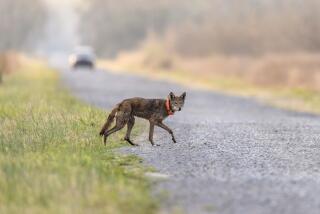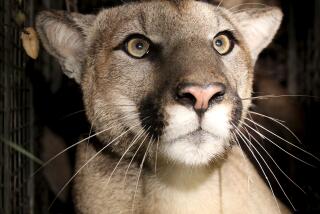Roadkill Research Helps Round Out School Science Class
- Share via
LOUDON, N.H. — Brewster Bartlett keeps his house filled with his favorite kind of animals: dead ones.
He has raccoon skins, a collection of picked-clean deer skulls, cat and dog bones, a full mouse skeleton and a near-complete snakeskin he keeps rolled in a ball. There is also a 2-foot-long stuffed rat his 3-year-old son keeps close by.
The macabre collection began as a hobby but is now a key part of Roadkill 2001, an educational program started by the so-called “Dr. Splatt” at Simmons College in Boston to teach a type of science hard to find in any textbook.
“Kids today don’t know the difference between an opossum and a raccoon when they run by,” said Bartlett, a former middle school science teacher. “But when they see them lying dead in the road, they stop, ask questions, and learn.”
The goal of the program isn’t just to teach children to identify dead animals. Its aim is also to teach students about technology, their environments and the live animals around them.
Bartlett developed the idea in 1992, on his way home from a seminar at Simmons, where he and a group of New England science teachers had decided to start an environmental monitoring project.
The topic they agreed on was lichens, the slow-growing green, fuzzy organisms that appear on trees. The goal was for schools in different areas to participate and to communicate their findings through e-mail.
But Bartlett was bored by the whole idea, and conceived what he thought was a better one as he drove past a dead skunk.
“I made a few calls and found out that the Department of Fisheries and Wildlife only monitors bear, moose and deer that are killed,” he said. “They said it was because they don’t have enough people to do more. But I knew where we could find plenty of people to do the work.”
The concept is simple.
Children from participating schools are responsible for monitoring and keeping track of the dead animals they see on the side of certain roads over a set period of time. When that period ends, the students draw conclusions from their data about the animal population in that region compared with findings in other communities.
A federal grant awarded to Simmons got Bartlett started in 1993 with a Web page that allowed schools to submit their findings and read results from other areas. Soon 100 schools from around the country were involved.
But when the grant ran out last year, the college dropped the program. It was recently put back online by EduTel, a Leominster, Mass.-based educational Web site. About two dozen schools have signed up for the program this year, and Bartlett said he is hopeful more will follow.
“I’d love to get to the point where we’re doing the whole world,” he said. “I’d love to know how many kangaroos are killed each year in Australia.”
Disgusting? Slightly, but also educational and completely fascinating for children, said Sheila Adams, a sixth- and seventh-grade teacher at Rye Junior High School. She has been using the project for eight years.
Though she insists her students only look--and never, ever touch--she encourages them to examine the animals closely and to write down everything they see.
“The fun part is watching things happen,” she said. “Sometimes we find patterns and sometimes we don’t,” she said. “But after this many years, we’ve developed a pretty good profile for the animal populations in our town.”
Over time, children have found dead cats, dogs, birds, turtles, frogs and even a fish on the side of the road.
One student came up with Bartlett’s now famous “Dr. Splatt” moniker, and another came up with a word for animals that are so squished they cannot be identified: URPs, or Urban Road Pizza.
“I always thought roadkill was really disgusting,” said 12-year-old Lorelle Dennis, one of Adams’ seventh-graders. “Now when I see dead animals I don’t look away, I chart them. Now they’re more interesting to me.”
Bartlett travels to participating schools in New England while they work on the project to check their progress, and to give them an up-close look at his own collection.
Most are fascinated by his animal bones, jockey for a chance to pet his raccoon hide, and oooh and ahhh at his snakeskin.
When he explains how some of them died--like the squirrel he found flattened in front of his house--it is then that the weak-stomached turn away.
But it all works together to drive home the idea that humans are encroaching on the space that the animals had first, he said.
“Kids just have no idea how many animals are out there and how many are killed every day because of cars,” he said. “In addition to everything else they learn, this is a real wake-up call for them.”
Wesley Chaput, a 13-year-old seventh-grader in Adams’ class, agreed.
“The animals were here first, and then we came in and made all the cars and the roads,” he said. “I know I wouldn’t like it if I was run over by a car. I feel sorry for them.”






